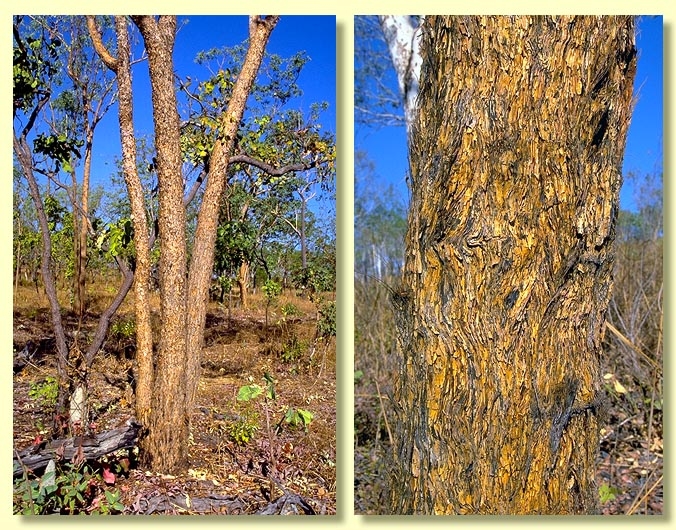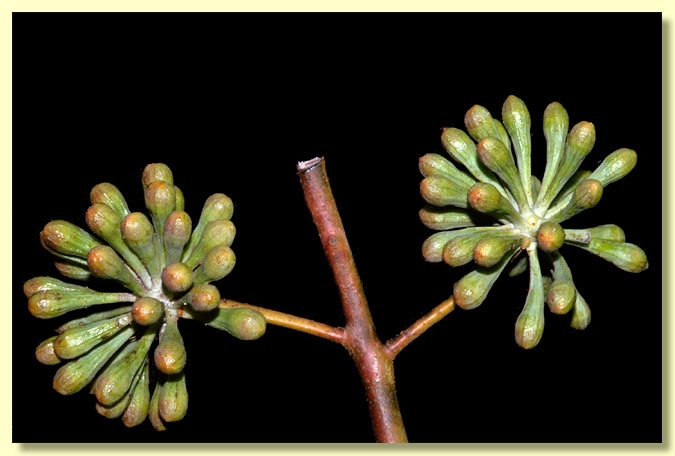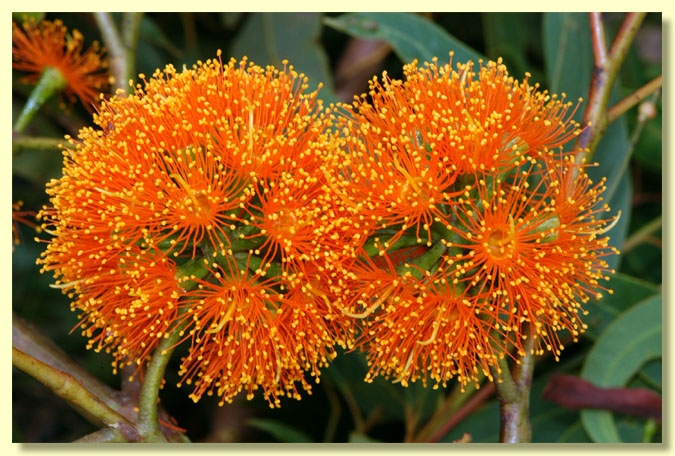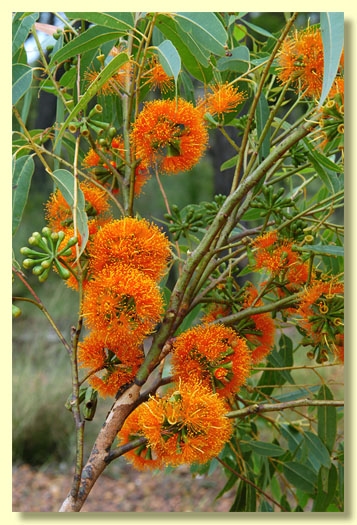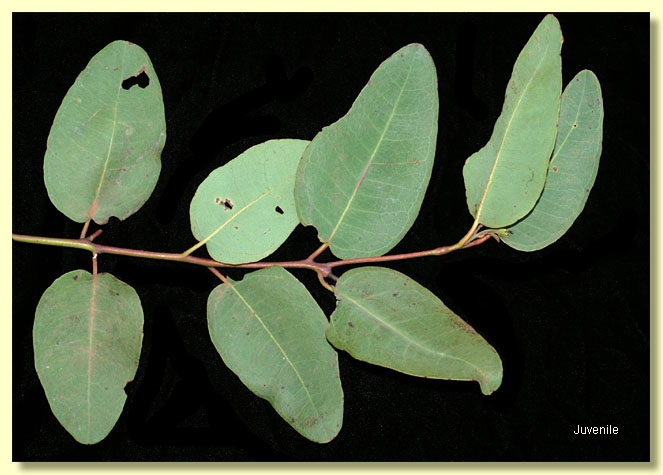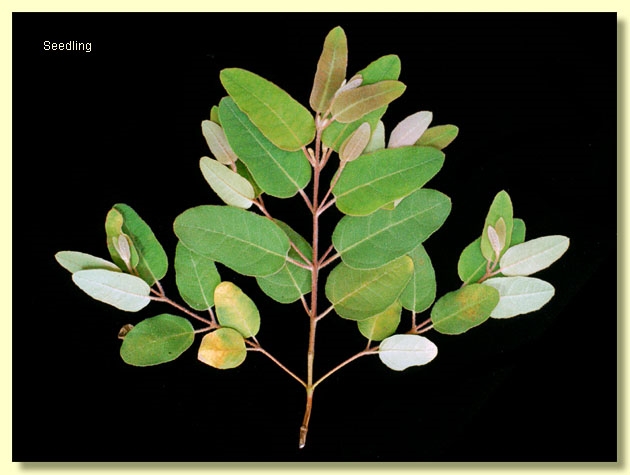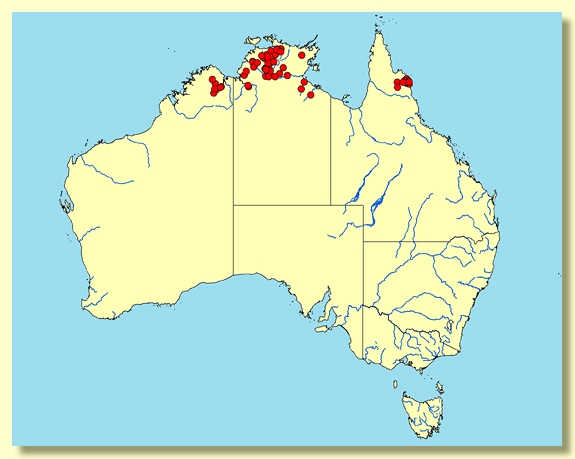Euclid - Online edition
Eucalyptus phoenicea
Eucalyptus | Eudesmia | Reticulatae | Miniatae | Inclinatae
Eucalyptus phoenicea F.Muell., J. Proc. Linn. Soc., Bot. 3: 91 (1859).
T: Northern Territory: Victoria River, near the main camp [i.e. c. 15° 35’ S 130° 25’ E ], F.Mueller s.n.; isolecto: BRI, K, MEL fide Hill & Johnson, Telopea 7 (4) 411 (1998).
Tree to 12 m tall, rarely multistemmed or mallee-like. Forming a lignotuber.
Soft fibrous, flaky, papery rough bark over most the trunk and larger branches, rough bark yellow-grey to yellow-brown to orange-brown. Large branches sometimes with grey to white to pinkish-grey smooth bark. Branchlets not glaucous.
Juvenile growth (coppice or field seedlings to 50 cm): stems rounded in cross-section, hairy; juvenile leaves opposite or alternate, petiolate, ovate to rarely elliptical, 4–13 cm long, 2–6 cm wide, base rounded to rarely shallowly lobed, apex rounded to acute, dull blue-green to green, with stellate hairs.
Adult leaves alternate, petioles 0.8–2 cm long; blade lanceolate, 6.5–14 cm long, (0.9)1.2–3(4.5) cm wide, base tapering to petiole, concolorous to slightly discolorous, dull green to grey-green to yellowish-green, side-veins at a wider angle than 45° to the midrib, tertiary venation moderate to dense, intramarginal vein present and very close to the margin, oil glands island or intersectional or obscure.
Inflorescence axillary single, peduncles 1.7–3.7 cm long, buds usually more than 7 per umbel, pedicellate, pedicels 0.4–1 cm long. Mature buds clavate to pyriform (0.8–1.9 cm long, 0.5–0.8 cm wide), bright green and not glaucous, calyx fused to the corolla and evident as 4 small teeth at the apex of the bud, hypanthium weakly longitudinally striated or ribbed, operculum rounded to conical, stamens inflexed, anthers oblong, versatile, dorsifixed, dehiscing by longitudinal slits (non-confluent), style long, straight or sometimes hooked or bent beneath the apex of the bud, stigma tapered, locules usually 2, the ovules usually arranged in 4 distinct vertical rows on the placentae. Flowers bright orange.
Fruit pedicellate, pedicels 0.4–1 cm long, cylindrical and urceolate, weakly longitudinally ribbed, 1.9–3 cm long, 0.9–1.3 cm wide, not glaucous, disc vertically descending, valves 2, enclosed.
Seeds dull dark grey to black, saucer-shaped to ± flattened ovoid, 3–5 mm long, dorsal surface smooth, rarely slightly lacunose, hilum ventral.
Cultivated seedlings (measured at node 10): cotyledons bilobed; stems round in cross-section, hairy, leaves petiolate, opposite, ovate to elliptical, 3–8.5 cm long, 2–4.5 cm wide, base rounded to shallowly lobed, apex rounded, dull, discolorous, blue-green to green, lamina hairy on both sides, margins sometimes appear toothed due to the hairs.
Flowering has been recorded in February, April, May, June, July, August, September and November.
A small to medium-sized tree of tropical far northern Australia, from the Pentecost Range in the Kimberley region of Western Australia extending sporadically east through the Top End of the Northern Territory from south of Timber Creek north to Peppimenarti and Batchelor east to Katherine Gorge, Oenpelli, Beswick, and the hinterland of the south-western Gulf of Carpentaria, with an isolated occurrence north-west of Cooktown in North Queensland. Eucalyptus phoenicea prefers sandstone escarpments and plateaus and stony rises and is characterised by its rough, papery or fibrous bark on the trunk and large branches, the many-budded umbels, usually more than 11 per umbel, the bright orange or scarlet filaments of the flower, and the distinctly urceolate fruit.
Eucalyptus phoenicea belongs to the taxonomically complex Eucalyptus subgenus Eudesmia and is included in the section Reticulatae, series Miniatae, subseries Inclinatae characterised by having the calyx fused to the corolla and evident as four small teeth at the apex of the bud, hairy seedlings, adult leaf reticulation relatively dense, buds with a long style and bright orange flowers. Within the subseries, it is closest to E. ceracea from the Seppelt Range area of the northern Kimberley in Western Australia. E. ceracea can be distinguished by its mature crown of sessile, ovate, glaucous, juvenile leaves and its glaucous buds and fruit (mature crown lanceolate, yellow-green to grey-green and buds and fruit not glaucous in E. phoenicea).
With its soft, fibrous, papery bark, its many-budded umbels, the bright orange to scarlet flowers and the long urceolate fruit, E. phoenicea should not be confused with any other eucalypt.
Eucalyptus phoenicea: the phoenix, the mythical Arabian bird, referring to the brilliant scarlet colour of the feathers of the bird, which the brilliance of the anther filaments of the flowers, if not their orange colour.



